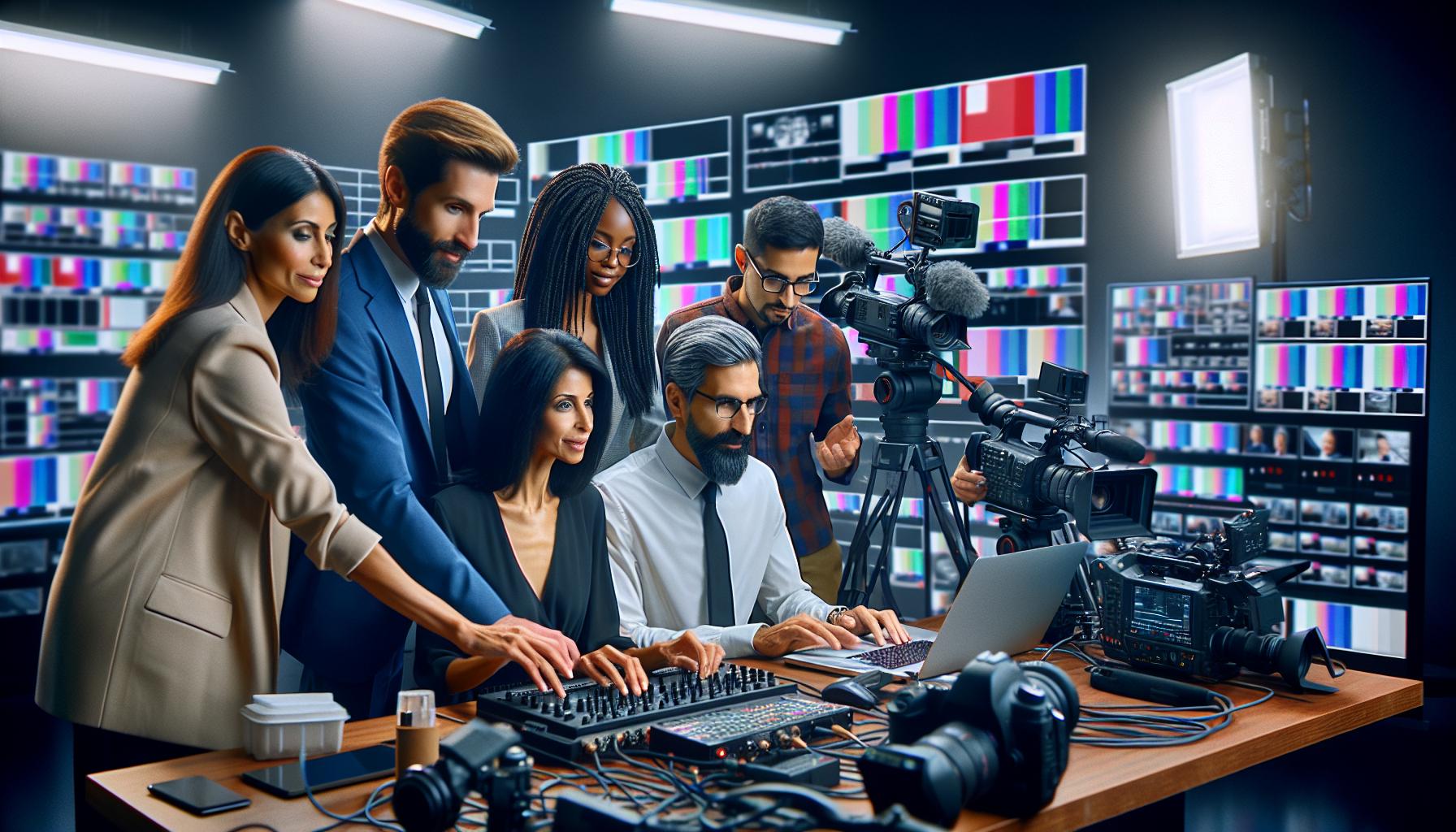Broadcast Media Production
- Comprehensive Process: Broadcast media production involves multiple phases—pre-production, production, post-production, and distribution—each critical to delivering high-quality content.
- Importance of Planning: Effective pre-production planning, including budgeting and scheduling, is vital for ensuring a smooth workflow and meeting project goals.
- Technological Advancements: Staying updated with the latest technologies, such as digital cameras, editing software, and live streaming tools, enhances production quality and creative capabilities.
- Audience Engagement Strategies: Understanding viewer preferences through data analytics is essential for tailoring content and fostering long-term audience loyalty.
- Trends to Watch: Key trends in the industry include an increased focus on streaming services, immersive technologies like VR/AR, and sustainable production practices that meet contemporary viewer demands.
In today’s fast-paced digital landscape, broadcast media production plays a crucial role in shaping how audiences consume information and entertainment. From news programs to captivating documentaries, the art of crafting compelling content has evolved dramatically. With advancements in technology, producers now have access to tools that allow for unprecedented creativity and efficiency.
Understanding the intricacies of broadcast media production is essential for anyone looking to make a mark in this competitive field. It encompasses everything from pre-production planning to post-production editing, ensuring that every element comes together seamlessly. As the demand for high-quality content continues to rise, mastering the techniques and strategies of broadcast media production becomes more important than ever.
Overview of Broadcast Media Production
Broadcast media production encompasses the comprehensive process of creating content for television, radio, and online platforms. It includes several critical phases, each contributing to the final output that captivates audiences and delivers information or entertainment effectively.
Pre-Production
Pre-production involves planning and organizing all aspects of a broadcast. It includes scriptwriting, budgeting, scheduling, and casting. Producers outline goals, define target audiences, and gather necessary resources during this stage.
Production
Production is the phase where the actual content is created. This stage includes filming, recording, and capturing audio and video footage. Crew members operate cameras, sound equipment, and lighting setups to ensure high-quality results.
Post-Production
Post-production focuses on editing and refining the produced content. Editors combine audio and visual elements, adding effects, music, and graphics to enhance the overall presentation. This stage also involves quality control to ensure the final product meets industry standards.
Distribution
Distribution entails delivering the finished content to audiences via various platforms. This can include terrestrial broadcasts, streaming services, and social media. Effective distribution strategies play a crucial role in maximizing reach and engagement.
Importance of Technology
Technological advancements significantly impact broadcast media production. Innovations in editing software, camera technology, and live streaming options enhance producers’ capabilities. Staying updated with the latest tools and techniques is essential for maintaining competitive advantages in the industry.
Audience Engagement
Audience engagement strategies are vital for successful broadcast media production. Understanding viewer preferences and trends can shape content creation, leading to higher audience satisfaction and loyalty. Producers often utilize analytics to inform future projects and tailor content to specific demographics.
Key Components of Broadcast Media Production

Broadcast media production consists of several key components that ensure the effective creation and dissemination of content. Understanding these elements enhances the quality of the final product and maximizes audience engagement.
Pre-Production Planning
Pre-production planning involves detailed organization and preparation. It includes scriptwriting, storyboarding, and scheduling. Producers coordinate logistics, select locations, and manage casting. Budgeting is crucial as it determines the scope of the project. By establishing clear objectives and timelines, teams can streamline processes and reduce potential delays during production.
Production Techniques
Production techniques encompass the actual filming or recording of content. This phase includes camera operation, sound recording, and lighting setup. Producers utilize various equipment, such as cameras, microphones, and lighting fixtures, to achieve the desired aesthetic. Attention to detail during this stage affects the overall quality of the broadcast. Effective communication among crew members ensures a smooth workflow, resulting in a cohesive final product.
Post-Production Processes
Post-production processes play a vital role in refining the initial footage. Editing, sound design, and color correction enhance the visual and auditory experience. Editors select the best takes, arrange sequences, and add effects, music, and voiceovers. Quality control is essential, involving reviews to ensure that the final product meets industry standards. This phase also includes formatting for various distribution platforms, ensuring accessibility for diverse audiences.
Equipment Used in Broadcast Media Production

Broadcast media production relies on various equipment to deliver high-quality content effectively. Key categories include cameras, lighting, and audio equipment.
Cameras and Lighting
Cameras play a crucial role in capturing visuals in broadcast media. Professional video cameras, such as digital cinema cameras and broadcast cameras, offer superior image quality and flexibility. They often come equipped with interchangeable lenses, allowing for creative adaptability during shooting. Lighting equipment, including softboxes, LED panels, and spotlights, ensures proper illumination on set. Utilizing a combination of key lights, fill lights, and backlights creates depth and enhances visual storytelling.
Audio Equipment
Audio equipment is essential for capturing clear sound in broadcast media production. Microphones, such as lavalier, shotgun, and handheld types, cater to various filming situations. Lavalier microphones provide discreet audio capture for interviews and presentations, while shotgun microphones focus on sound from a specific direction, minimizing background noise. Additionally, audio mixers and digital audio recorders enhance sound quality during production. Employing soundproofing techniques and monitoring audio levels throughout the process ensures a polished final product.
The Role of Technology in Broadcast Media Production

Technology plays a crucial role in broadcast media production, transforming how content is created and delivered. Advances in equipment and software significantly enhance production quality, enabling producers to engage audiences effectively.
Key Technological Innovations
- Digital Cameras
Digital cameras capture high-definition visuals, improving image clarity and detail. Cameras like the RED Komodo and Canon C300 allow for stunning cinematography.
- Editing Software
Editing software, such as Adobe Premiere Pro and Final Cut Pro, streamlines post-production processes. These tools facilitate efficient editing, color correction, and sound design.
- Audio Technology
Advances in audio technology enhance sound quality. High-quality microphones, digital audio recorders, and audio interface mixers improve sound capture and clarity.
- Lighting Equipment
Sophisticated lighting equipment, including LED panels and softboxes, helps create the desired mood and atmosphere. Proper lighting techniques elevate visual storytelling.
- Live Streaming Tools
Live streaming technology supports real-time broadcasting, connecting producers with audiences instantly. Platforms like OBS Studio and vMix enable seamless live events.
Data Analytics and Audience Engagement
Utilizing data analytics optimizes content strategies. Producers analyze viewer preferences and behaviors, tailoring content to meet specific demands. This targeted approach enhances audience engagement and fosters loyalty.
Remote Production Capabilities
Remote production technology allows teams to collaborate efficiently from different locations. Tools like Zoom and remote camera systems facilitate communication, ensuring smooth workflows regardless of physical presence.
VR and AR Technologies
Virtual reality (VR) and augmented reality (AR) technologies are emerging trends in broadcast media. They offer immersive experiences, enhancing audience interaction with content. Producers can create dynamic narratives that captivate viewers.
Through these technological advancements, broadcast media production continues evolving. Understanding and leveraging these tools fosters creativity and efficiency, ultimately delivering high-quality content to diverse audiences.
Trends in Broadcast Media Production
Broadcast media production experiences continuous evolution due to rapidly changing technologies and audience preferences. Key trends shape its landscape:
- Increased Use of Streaming Services: Streaming platforms dominate viewership, prompting producers to create content tailored for on-demand consumption.
- Integration of Virtual and Augmented Reality: Virtual reality (VR) and augmented reality (AR) technologies enhance storytelling by offering immersive experiences. Productions use these tools to engage audiences in new ways.
- Advanced Editing Techniques: Automated editing software streamlines post-production processes, allowing creators to focus on creative aspects rather than technical tasks.
- High-Quality Live Streaming: Live broadcasting gains popularity with advancements in streaming technology, enabling real-time interactions between producers and audiences.
- Collaboration Tools for Remote Production: Remote production solutions facilitate collaboration among team members across different locations, maintaining productivity even when physically apart.
- Data-Driven Content Strategies: Analytics tools provide insights into viewer preferences, allowing producers to craft content that resonates with specific demographics.
- Sustainable Production Practices: Sustainable practices in media production reduce environmental impact, prompting many to adopt eco-friendly methods and materials.
- Enhanced Audience Engagement: Interactive content that encourages viewer participation, such as polls and Q&A sessions, creates deeper audience connections.
Evolving technologies drive these trends, making it essential for professionals in the broadcast media production industry to stay informed and adapt to changes.
Adaptability and Innovation
Broadcast media production is an ever-evolving field that demands adaptability and innovation. As technology advances and audience preferences shift, professionals must stay ahead of the curve to create engaging content. Mastering the entire production process is essential for success, from meticulous planning to seamless execution and effective distribution.
Embracing emerging trends like VR and AR can elevate storytelling and captivate viewers. By leveraging analytics and understanding audience dynamics, producers can tailor their content for maximum impact. The future of broadcast media production lies in a commitment to quality, creativity, and a deep understanding of the tools available. This dedication will ensure that content not only meets industry standards but also resonates with diverse audiences.

